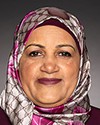Thank you for that question.
That is such a hot-button issue here. Indeed, we have a kind of bias toward this nuclear family, which might represent my cultural space, but it doesn't necessarily represent many of the spaces of the people I work with, globally.
In fact, when you start thinking about who would be most effective for child care, it might be an aunt or an uncle. Our bias tends to be to define those key players as the grandparent or the parent, when in many other cultures that just wouldn't be the case. It would not be uncommon for a child to be actually raised by multiple parental figures in a home. We sort of shortchange that, creating more stress for families, when we have this bias toward one particular individual.
In fact, I would almost go out on a limb and say that in most cultures that I'm familiar with—if we really look at the global situation—it's quite unusual to have a nuclear family. It's an oddity, globally. Certainly, burdening grandparents, who are elderly, with care of young children is even a bit odder, globally. It doesn't tend to be like that. It tends to be more extended family, and you need a critical mass of people to create that.
There are sociologists, for instance—just a very small quip—who say that we pathologize single parents, but we don't have to. We just ask if a parent is single, married, or in a common-law relationship, and we sort of tick the box in our census, and everything else. But the real question that should be asked is, “If there was a crisis at midnight tonight, how many metres away would you need to go until you could find someone to actually help you with your children?” That is the benchmark of a cohesive community, and that's the way we need to be thinking about this—creating that critical mass of supports for people, which, I think, is what people naturally do when they do a secondary migration once they are inside the country.




